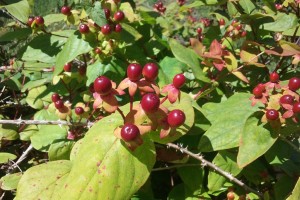Tutsan rust
History in New Zealand
Tutsan rust is native to Europe. It was first noticed in New Zealand in 1952, and within a few years was widespread. It is not known how tutsan rust got to New Zealand. This rust is believed to be responsible for a considerable decline in tutsan (Hypericum androsaemum) populations observed here during 1970s, 80s and 90s. However, there has been a resurgence of tutsan as a problem in some parts of the North Island in recent decades. In response the Tutsan Action Group formed and contracted Landcare Research to explore options for improving biocontrol of tutsan.
Molecular studies have been undertaken to try to understand the variable impact of the rust. They have shown that there are four tutsan genotypes here compared with eight in Europe. However, only two genotypes are common here, with one mainly occurring in the North Island and the other in the South Island. The North Island plant genotype originates from Europe while the South Island plant genotype originates in the UK. There are four genotypes of tutsan rust in Europe of which two occur here. The two rust genotypes appear to be closely associated with two main genotypes of tutsan plants, so one is mainly found in the North and the other in the South Island.
The common tutsan plant genotype found in the North Island appears to have become resistant to the rust over the past 20-30 years, leading to a resurgence of tutsan as a problem there. Tutsan rust also appeared in Victoria, Australia, in the early 1990s, and initially provided good control that also did not last. However, it seems likely that the rust is still keeping South Island tutsan populations under control as the plant is neither common nor invasive in this part of the country. Studies have suggested that the other rust strains present in Europe will not be effective on the problematic tutsan genotype here, and so insect biocontrol agents are being utilised instead in an attempt to improve tutsan control.
See Tutsan beetle, Tutsan moth.
How would I find/recognise it and what is its lifecycle?
The best time to see symptoms of the rust is late summer and autumn. Look for conspicuous yellow-brown spots, 2–3 mm in diameter, on the upper surfaces of the leaves. Turn these leaves over to see corresponding orange powdery pustules, up to 1 mm across, on the undersides. Sometimes the pustules will also be present on stems and fruits. The orange spores produced by the pustules are spread by wind and rain to cause new infections.
Image: tutsan rust pustules on the underside of the leaf.

Image: close up of tutsan rust pustules on the underside of the leaf.
Heavily infected plants may sometimes look as though they have been sprayed with herbicide. The leaves of heavily infected plants turn yellow prematurely and may shrivel and fall from the plants. The rust can also kill stems. There are no other rusts on tutsan in New Zealand for you to confuse with tutsan rust.
How does it damage tutsan?
The orange spores germinate in the presence of moisture and enter the leaves through the stomata on the lower surfaces. Heavily infected leaves are usually killed, and the youngest leaves at the shoot tips are particularly susceptible. Rust damage can cause plants to drop all their leaves and sometimes their fruits, however, the North Island plant genotype will often recover from this damage and regrow healthy foliage the following spring/summer. In the South Island tutsan plants appear to not recover from rust defoliation and stem infection.
Image: tutsan rust damage.
Will it attack other plants?
Tutsan rust is highly host specific and there are no records of it attacking any other plants in New Zealand. In Europe tutsan rust is recorded as attacking St John’s wort (Hypericum perforatum) but this has never been seen here.
How effective is it?
The impact of tutsan rust in New Zealand was spectacular during the 1970s through to the 1990s until some populations appear to have become resistant. However, the rust still appears to keep tutsan under control in the South Island.
Image: tutsan plant damaged by tutsan rust
How can I get the most out of it?
The tutsan rust is already widely established so there is little to gain by spreading it around further. Plants that are not infected are likely to be resistant.
Key contact



